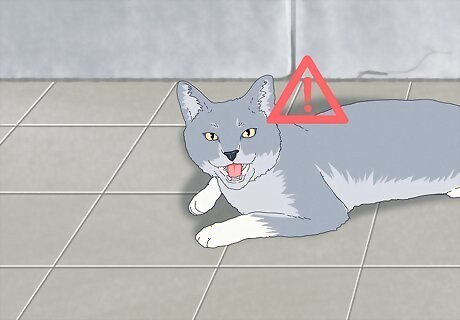
views
Approaching a Friendly Cat

Leave out a bowl of dry cat food. You will need to start by gaining the cat’s trust, as this will make approaching the cat much easier. You can gain the stray cat’s trust by leaving out a bowl of dry cat food where they can see it. The stray cat is likely hungry and will be more inclined to approach your area if you present it with food. Place the dry cat food in a bowl close to the cat or in the area where the cat is hanging out. You may also leave out a bowl of fresh water for the cat to drink. Then, step away and wait quietly for the cat to approach and eat from the bowl. Let the cat continue eating and drinking without approaching it. If you are not worried about approaching the stray cat right away, you may continue to leave food and water out for the cat every day until the cat seems comfortable staying in the same area.

Move toward the cat slowly and quietly. Do this while the cat is eating from the food bowl. Talk quietly to the cat as you move towards it slowly. You may say, “Good kitty” under your breath or simply, “Hi there, kitty.” Talking to the cat in low tones will show it you are non-threatening and friendly. If the cat appears spooked by your presence, take a few steps back and wait. Once the cat appears less freaked out by you, you should take a few steps forward and continue talking quietly. Over time, the cat should realize you are not a threat and be more comfortable with your presence.

Allow the cat to come to you. Do not try to force the cat to come to you or attempt to grab the cat as this will just scare it more. Instead, allow the cat to approach you. Squat down a few feet away from it and continue to speak softly to it. The cat should come to you and rub your leg or sit near you but just out of reach. These are signs it does not view you as a threat. Avoid trying to reach out and pet the cat or stroke the cat. This may spook it and cause it to run away. Be patient and allow the cat to approach you.

Lure the cat into your car or into a container. If you have confirmed the cat is a stray and it appears okay with you approaching it or it approaches you, you may be able to lure it to a safe place. You should try to lure the animal into your car by placing food on the seat and leaving the door open. If the cat does go into your car, you should close the door and go get help. You can also try luring the cat into a container, such as a cardboard box or a plastic bin. You can leave food in the box or bin and see if the cat will enter it willingly. Once the cat is in the box or bin, you can then call for help.

Try to find the cat’s owner. If you are able to transport the cat in your car, you should take it to the nearest animal shelter. The shelter may then be able to help you find the cat’s owner, if it has one. You should also check the cat for any identification, such as a collar or a tag. You may be able to find the owner through the information on the cat’s collar. You should make sure the shelter scans the cat for a microchip. If the cat has a microchip, scanning it will make it easier to identify the cat’s owner. You can help the shelter find the cat’s owner by posting a “found” ad in your local newspaper or online. You can also put up “found cat” posters in your neighborhood with an image of the cat. You may decide to keep the cat if the owner is not found through the shelter. If so, you should notify animal control that you have the cat and then take the cat to the vet for a check up. The vet will confirm the cat does not have any diseases or illnesses.
Approaching a Frightened or Feral Cat

Watch for signs of aggression. The stray cat may appear frightened and scared by you, especially if is it not used to other people or to being outside. A frightened cat may hiss, growl, or spit at you. These are normal signs of fear and the cat may just be reacting to being lost, away from its owner, or outdoors. An aggressive cat may howl at you and its eyes may be dilated, with its fur on end and its head cocked back. If the cat starts to act aggressive, it may be feral. Feral cats are cats that have always lived outdoors and have not been socialized to people. They usually cannot be adopted and may end up in a kill shelter if they are caught. You may try to approach the feral cat anyway to ensure it is not sick or in danger, but do so with caution. If the cat allows you to approach it or if it approaches you, it is likely not feral. A stray cat will be okay with rubbing your leg or being close to you. A feral cat will likely not approach you at all and may hide or run away at the sight of you. Stray cats also tend to walk like house cats, with their tail up. Feral cats may stay low to the ground, crouching or crawling, and protect their body with their tail. Feral cats also will not make eye contact with you and will not purr, beg, or blink at you.

Wear gloves and long sleeves. You should approach a frightened or feral cat with caution and protect yourself against getting scratched or injured by the cat. Wear rubber gloves and a long sleeved shirt so your skin is not exposed. You should also have a towel or blanket ready to throw over the cat. Putting a towel or blanket over the cat can make it easier to put up the cat and transport it without getting scratched or attacked.

Let the cat approach you. Though the cat may appear frightened or scared, it may eventually approach you if you place a bowl of dry food and water in its area. You should leave the food and water out so the cat can eat and drink. Stay a few feet away from the cat so it does not feel threatened by you. You may then be able to move closer to the cat or get it to approach you by talking quietly to it. You may say, “Here, kitty” or “Hello there.” With enough coaxing, the cat may come to you. If the cat is feral or acting aggressive, it may not approach you. You can try throwing the blanket or towel over the cat. Then, lift it by the nape of its neck and try to put it in a box or in a container.

Call animal control if the cat is too aggressive. If the cat appears too aggressive, you may want to contact animal control so they can remove it safely and efficiently. Give animal control your contact number and ask them how long it will take for someone to get to the scene. Try to stay in the area until animal control arrives to make sure the cat is picked up safely. If you are not able to stay on the scene, you should describe where the cat is located by giving animal control a description of any road names, landmarks, or mile markers in the area. This will make it easier for animal control to locate the stray cat when they arrive.



















Comments
0 comment